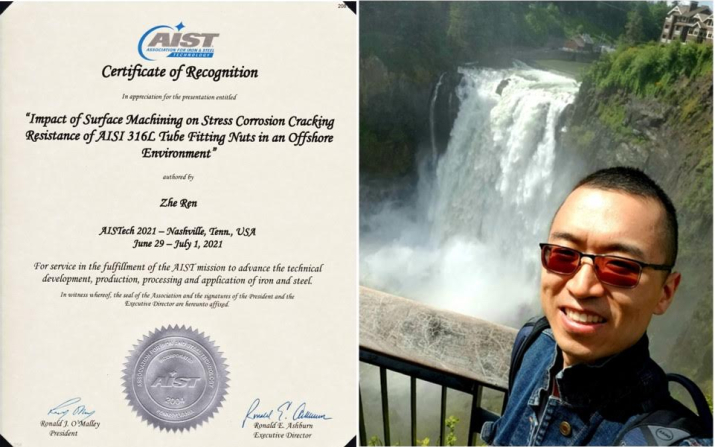Zhe Ren presents at AISTech

At AISTech2021 held at Music City Center in Nashville, Tenn., Zhe Ren’s presentation “Impact of Surface Machining on Stress Corrosion Cracking Resistance of AISI 316L Tube Fitting Nuts in an Offshore Environment” was praised by conference leadership for “fulfillment of the AIST mission to advance the technical development, production, processing and application of iron and steel.”
Ren, a postdoc scholar in Case Western Reserve University’s department of materials science and engineering, was motivated to submit an abstract by his interest in the current steel industries' perspectives and actions on the undergoing digital transformation, decarburization, and other new trends. In 2020, Ren published a paper on the same topic. Shortly after he submitted his abstract, he was invited to speak at the conference.
This was Ren’s first time speaking at AISTech, though he also presented at ASM International Heat Treatment in 2017 and MS&T in 2018. Both those presentations took place during his PhD studies at CWRU and he had a different approach for this presentation. “Rather than feeling obligated to seriously showcase everything like when I was a student, I keep in mind the key info I want to pass to the attendants, while at the same time engaging my audience by providing background stories and throwing away questions,” he said.
"After a long period of semi-quarantine life, this experience made me appreciate the chance to attend the conference and meet with experts in the field,” said Ren. After his presentation, an assistant professor from University of Alabama stood up and complimented Ren’s work. He was particularly interested in the characterization work Ren had done to differentiate martensite from ferrite embedded in the austenite matrix by identifying the misorientation angles, which was characterized by the ASTAR system (precession electron diffraction) incorporated in TEM. “The talk went very well and many attendants were interested in the characterization methods and the capability we have here,” said Ren.
Ren’s primary interests in materials science and engineering include gas diffusion treatment, surface engineering and characterization of alloys, data-driven materials development & performance prediction, in-situ characterization & testing, and energy materials development. He was drawn to the field of materials science and engineering during his undergraduate studies at Tianjin University in China, where he majored in Materials Forming and Controlling Engineering, an interdisciplinary major including materials science, control engineering, and mechanical engineering. The field of materials engineering interested him the most and his interest was spearheaded by a research project of designing ultrahigh temperature composites for a space shuttle.
Throughout his career as an engineer, Ren is most proud of designing Ultra-High Strength and Ultra-Corrosion Resistant Alloy by infusing foils of austenitic stainless steel AISI-316 with carbon at low temperature to generate a solid solution with extremely high spatially uniform levels of carbon (10 at%). While working on this project, Ren and other researchers created a new material.
In the long-term, Ren hopes to become a faculty member at a research university.
Ren’s abstract:
To understand the effect of surface machining on the resistance of AISI 316 L compression fitting nuts to stress–corrosion cracking (SCC) in an offshore environment, AISI 316 L nuts surface-machined by different methods were tested in a salt-spraying chamber. Under constant testing conditions, significantly different SCC resistance was observed depending on how the nuts had been machined. Microstructural analysis of the nuts' cross-sections and statistical evaluation of the nut surface-crack density indicate that machining by a “form” tool yields a crack density one order of magnitude lower than machining by a “single-point” tool.
